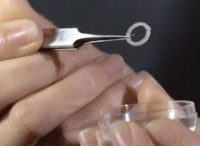Researchers have developed a new kind of biodegradable disc that can grow stem cells on the eye to repair a damaged cornea.

A biodegradable disc, loaded with a patient’s own stem cells, can be used to repair damaged corneas.
Using a combination of techniques known as microstereolithography and electrospinning, engineers at the University of Sheffield in the UK were able to create a membrane of biodegradable material that is placed over the damaged cornea. Shaped as a disc, the membrane is then loaded with the patient’s stem cells from the healthy eye, which then multiply and grow to form ocular tissue that will not be rejected.
The technique is ideal for use in developing countries, where corneal injuries are more common yet corneal grafting is not readily available. But it will be useful in developed countries, as well. “The current treatments for corneal blindness use donor tissue to deliver the cultured cells, which means that you need a tissue bank. But not everyone has access to banked tissues, and it is impossible to completely eliminate all risks of disease transmission with living human tissue,” says study coauthor Frederik Claeyssens, PhD, of the Department of Materials and Engineering at the University of Sheffield. “By using a synthetic material [as a base], it will eliminate some of the risk to patients and be readily available for all surgeons. We also believe that the overall treatment using these discs will not only be better than current treatments, it will be cheaper as well.”
Ortega I, Ryan AJ, Deshpande P, et al. Combined microfabrication and electrospinning to produce 3-D architectures for corneal repair. Acta Biomater. 2012 Nov 3. [Epub ahead of print]

